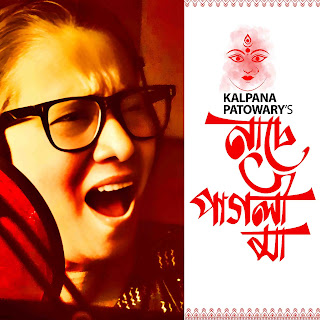मैं, कल्पना पटोवारी, असम के बारपेटा में जन्मी, लोकगायक स्वर्गीय बिपिन पटोवारी और श्रीमती जयमती पटोवारी की पुत्री हूं। मैंने अपने पिता से ही संगीत की प्रारंभिक शिक्षा ली और केवल 4 वर्ष की उम्र में उनके साथ सार्वजनिक मंचों पर प्रस्तुति देना शुरू कर दिया। मैंने गुवाहाटी के कॉटन कॉलेज से अंग्रेजी साहित्य में स्नातक की डिग्री प्राप्त की और लखनऊ के भातखंडे महाविद्यालय से हिंदुस्तानी शास्त्रीय संगीत में ‘संगीत विशारद’ की उपाधि प्राप्त की।
बाद में मैं मुंबई आ गई और भारतरत्न उस्ताद ग़ुलाम मुस्तफ़ा ख़ान साहब से शास्त्रीय गायन में प्रशिक्षण प्राप्त कर उसमें महारत हासिल की। मैंने ऑल इंडिया रेडियो और दूरदर्शन के लिए रिकॉर्डिंग की। मैं समाज सुधारक लोक कलाकार भिखारी ठाकुर की लोक विधा के संरक्षण के लिए समर्पित हूं, जो बिहार की सांस्कृतिक विरासत में गहराई से रची-बसी है।
मेरे अंतरराष्ट्रीय सहयोगी एल्बम Voyage 2 को 67वें ग्रैमी अवॉर्ड्स में Global Music Performance श्रेणी में विचार हेतु प्रस्तुत किया गया था। मैंने 30 भारतीय भाषाओं और बोलियों में 16,000 से अधिक गीत गाए हैं, जिससे भारत की भाषायी विरासत को संरक्षित किया है।
मेरे कार्यों में डिओरी, बोडो और ब्रजावली जैसी लुप्त होती भाषाओं का पुनर्जीवन मेरा समर्पण दर्शाता है, जो भारत की भाषायी विविधता को उजागर करता है। मैं पहली महिला हूं जिसने छपरा हीया पूर्वी जैसे पारंपरिक लोक शैली, जिसे पहले केवल पुरुष गायक प्रस्तुत करते थे, को मंच पर प्रस्तुत किया और प्रलेखित भी किया।
मैंने प्रतिष्ठित मंच MTV कोक स्टूडियो पर खादी बिरहा प्रस्तुत किया। मुझे ICCR (भारतीय सांस्कृतिक संबंध परिषद) द्वारा गयाना, त्रिनिदाद और सुरिनाम आमंत्रित किया गया। मैंने बॉलीवुड फिल्मों वेलकम, आर... राजकुमार और विद्या बालन की बेगम जान (जिसमें संगीत अनु मलिक ने दिया था) में पार्श्वगायन किया।
इस महाकुंभ में मैंने प्रसिद्ध संगीतकार लुईज़ बैंक्स के साथ मिलकर गंगास्नान गीत जारी किया। साथ ही, मैंने महात्मा गांधी के ‘चंपारण सत्याग्रह’ पर भी कार्य किया है।

स्पष्टीकरण
मैं विनम्रता पूर्वक कहना चाहती हूँ कि मैं भारत की उन गिने-चुने गायिकाओं में से हूँ जिन्होंने 30 भारतीय बोलियों में अपनी आवाज़ दी है। देओरी, बोडो और मिशिंग जैसी बोलियाँ, जिन्हें यूनेस्को द्वारा संकटग्रस्त घोषित किया गया है, उन पर भी मैंने कार्य किया है। मेरे कुछ प्रोजेक्ट्स जैसे देओरी में 'जिमोछाया' और बोडो में 'बाटौ गीत' के माध्यम से मैं इन भाषाओं को डिजिटल रूप से संरक्षित और प्रचारित कर रही हूँ ताकि आने वाली पीढ़ियाँ इन्हें जान सकें।
मैंने भोजपुरी लोक संगीत को संरक्षित और बढ़ावा देने में भी महत्वपूर्ण योगदान दिया है, जो भारत की अमूर्त सांस्कृतिक विरासत का एक महत्वपूर्ण हिस्सा है। भिखारी ठाकुर — जिन्हें भोजपुरी का शेक्सपीयर कहा जाता है — को समर्पित मेरे श्रद्धांजलि कार्यक्रम पारंपरिक कलाओं के प्रति मेरी प्रतिबद्धता को दर्शाते हैं।
मैंने भोजपुरी, असमिया और बॉलीवुड पार्श्वगायन जैसी अनेक संगीत शैलियों में दक्षता प्राप्त की है, जो मेरी पेशेवर उत्कृष्टता का प्रमाण है। मेरी यह क्षमता कि मैं क्षेत्रीय लोक संगीत को आधुनिक संगीत से जोड़ सकूं, दर्शकों को आकर्षित करती है और भारतीय प्रदर्शन कलाओं के दायरे को बढ़ाती है।
2018 में ऑस्ट्रेलिया के क्वींसलैंड में कॉमनवेल्थ गेम्स के समापन समारोह, एमटीवी कोक स्टूडियो, और मुंबई के पैडी फील्ड्स म्यूजिक फेस्टिवल में मेरे प्रदर्शन मेरे द्वारा भोजपुरी सांस्कृतिक पहचान को मनाने और बनाए रखने की भूमिका को उजागर करते हैं।
1982 से अब तक मेरे प्रदर्शन कला के प्रति निरंतर समर्पण के 43 वर्षों की लंबी यात्रा, मेरे उच्च स्तरीय पेशेवर योगदान को सम्मानित करती है। मैं लोक संगीत — चाहे वह भोजपुरी हो या असम के जनजातीय लोक रूप हों — के लिए आवाज़ उठाती हूँ, जो मुख्यधारा या शास्त्रीय शैलियों की तुलना में अक्सर उपेक्षित रहते हैं। यह बात मेरे द्वारा हाशिए पर पड़े कला रूपों को ऊँचा स्थान दिलाने की प्रतिबद्धता को दर्शाती है।

जानकारी
मेरे अंतरराष्ट्रीय प्रभाव का प्रमाण यह है कि स्टैनफोर्ड यूनिवर्सिटी, कैलिफोर्निया ने मेरे भिखारी ठाकुर पर किए गए कार्य की समीक्षा के लिए 25 छात्रों को मुंबई भेजा।
मेरी एक उल्लेखनीय उपलब्धि वर्ष 2015 में वाराणसी में भारत के प्रधानमंत्री श्री नरेंद्र मोदी और जापान के प्रधानमंत्री शिंजो आबे के बीच हुए भोज में गंगास्नान — गंगा नदी पर आधारित एक संगीतमय प्रस्तुति — देना रही।
सूरीनाम के एक समाचार पत्र ने वर्ष 2014 में मुझे "भोजपुरी वंडरकिंड" कहा और अपने मुखपृष्ठ पर प्रमुखता से प्रकाशित किया।
मुझे कई अंतरराष्ट्रीय और राष्ट्रीय पुरस्कारों से सम्मानित किया गया है:
• 2018 में मलेशिया में हुए इंटरनेशनल भोजपुरी फिल्म अवॉर्ड्स में सर्वश्रेष्ठ भोजपुरी महिला पार्श्व गायिका का पुरस्कार
• 2016 में आईबीएफए दुबई, यूएई, 2015 में आईबीएफए मॉरिशस
• 2018 में भोजपुरी सिने अवॉर्ड्स, कोलकाता
• 2007 में मुंबई, 2013 में लखनऊ, 2014 में मुंबई में सर्वश्रेष्ठ भोजपुरी पार्श्व गायिका का पुरस्कार
• 2019 में भिखारी ठाकुर की लोकशैली को राष्ट्रीय और अंतरराष्ट्रीय मंचों तक पहुँचाने के लिए विशेष सम्मान
2017 में मुझे भारत रत्न अंबेडकर अवॉर्ड से सम्मानित किया गया, यह सम्मान सामाजिक न्याय और अधिकारिता राज्य मंत्री श्री रामदास अठावले ने नई दिल्ली में 20 माननीय सांसदों की उपस्थिति में प्रदान किया।
2012 में झारखंड के राज्यपाल सय्यद अहमद द्वारा रांची में सम्मानित किया गया, और 2007 में झारखंड के मुख्यमंत्री अर्जुन मुंडा द्वारा जमशेदपुर में सम्मानित किया गया।











